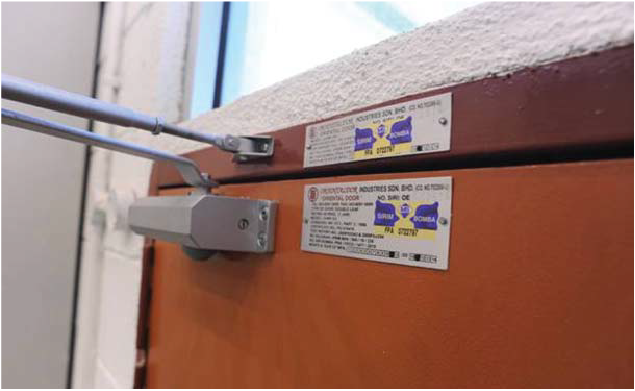By Mohd Shaharin Ahmad Latif
Fire resistant doorsets, also known as fire doors, are ubiquitous in commercial buildings and residential buildings such as condominiums and apartments. It falls under the passive fire protection category. Depending on the design, raw materials and components used, the fire resistant doorsets can be classified as composite fire resistant doorset, steel fire resistant doorset, glass fire resistant doorset and timber fire resistant doorset. It typically has a fire rating of ½ hour, 1 hour, 2 hours or 4 hours. The two types of fire resistant doorsets are single leaf and double leaf doorsets. A complete fire resistant doorset shall consist of door leaf, door frame, ironmongery (lockset, door closer, hinge, and door coordinator as well as auto-bolt for the double leaf type). Usually, the usage will determine the required or suitable classification, rating and type of doorsets.
In Malaysia, fire resistant doorsets are regulated by Fire and Rescue Department of Malaysia (FRDM or Jabatan Bomba dan Penyelamat Malaysia) based on requirements stipulated in the Fire Services Act and Uniform Building By-Law 1984. All fire resistant doorsets sold in Malaysia requires FRDM’s approval by means of ‘Sijil Perakuan Bahan BOMBA’. FRDM has made Product Certification Scheme a mandatory requirement for obtaining this approval. SIRIM QAS International has been entrusted by FRDM to carry-out this Product Certification Scheme based on the latest Malaysian Standard, MS 1073: Part 3: 1996 (Amd.1: 2003) ‘Specification for fire resistance doorsets Part 3: Methods for determination of the fire resistance – type of doorsets’ and FRDM’s directive, ‘Arahan Keselamatan Kebakaran Bilangan 2 Tahun 2012 (JBPM/IP/BKK:700- 1/1/1(21))’.
The Product Certification Scheme for fire resistant doorsets offered by SIRIM QAS International conforms to product certification system Type 5 which is specified in Guide 65 ‘General requirements for bodies operating product certification systems’. It requires sampling, testing, review, decision on certification, licensing, quality system audit and surveillance which include assessment of production process and testing of sample from open market and factory. The certification process is illustrated in Table 1.
Table 1: Certification Process
| Sequence | Flow | Process |
|---|---|---|
| Step One | Application | • Application form • Questionnaire form • Approval from relevant authority form • Trademark registration form • Technical drawing |
| Step Two | Costing & Quotation | • Preparation of costing sheet • Issuance of quotation for certification |
| Step Three | Open File & Documentation Audit | • File opened after payment of application fee • Issuance of Acceptance Letter • Issuance of testing requisition |
| Step Four | Verification & Sampling for Testing | • Issuance of quotation for testing fee • Job no. issued after payment of fee • Conducted at factory |
| Step Five | Testing & Issuance of Testing Report | • Test carried-out after 28 days of installation (conditioning) • Issuance of Test Report |
| Step Six | Initial Audit | • Verification of quality system at factory • Based on Standard, Product Certification requirements & manufacturer’s quality control plan |
| Step Seven | Recommendation for License | • Preparation of Recommendation report • Approval by the Certification Panel |
| Step Eight | Surveillance | • Conducted twice yearly |
The two main elements in the Product Certification Scheme requirements are quality system and product testing. In quality system requirements, applicant shall establish a satisfactory quality system whereby the quality control (QC) activities carried-out covers the whole production process starting from the incoming of raw materials, in-process to finished product as well as equipment calibration, mechanism for handling customer complaints and product failures. The quality system shall be able to ensure a consistent quality of product being produced at the factory.
For product testing, on the other hand, all fire resistant doorsets shall pass the fire resistance test and cyclic movement endurance test in accordance with the applicable or relevant standard i.e. MS 1073: Part 3: 1996 (Amd. 1: 2003).
Fire resistance test consists of integrity and insulation requirements. Details of the requirements are shown in Table 2:
Table 2: Requirements of fire resistance test
| Doorset classification | Composite/ timber/ steel/ glass | |||
|---|---|---|---|---|
| Rating | ½ hour | 1 hour | 2 hours | 4 hours |
| Integrity (minute) | 30 | 60 | 120 | 240 |
| Insulation (minute) | 30 | 60 | 60 | 120 |
Integrity
The ability of a specimen of a doorset to contain a fire to specified criteria for collapse, freedom from holes, cracks and fissures and sustained flaming on the unexposed face.
Insulation
The ability of a specimen of doorset to restrict the temperature rise of the unexposed face to below specified level.
Figure 1: SIRIM fire-rated label

Figure 2: SIRIM mark for certified products.

Cert. to: MS 1073: Part 3: 1996 (Amd.1: 2003)
Cert. no.: PCXXXXXX*
* Note: Refers to the number printed to the licence

Cyclic movement endurance test requires the fire resistant doorsets to undergo and pass 100,000 cycles and the power size of door closer shall be as specified in Standard MS 1073: Part 3: 1996 (Amd.1: 2003). The door size for cyclic movement endurance test and fire resistance test shall be similar. Product Certification licence will only be awarded to the manufacturer after these two elements are satisfactorily fulfilled.
Decision on the award of a Product Certification licence to a manufacturer will be made by an independent panel. In addition to the manufacturer’s product marking, fire-rated label and SIRIM MS Mark must be displayed on all certified fire resistant doorsets.

For more information, please contact:
Sales, Marketing & Business Development Section SIRIM QAS International Sdn. Bhd.
Tel: +603–5544 6400
Fax: +603–5544 6810
Website: www.sirim-qas.com.my
Email: qas_marketing@sirim.my
